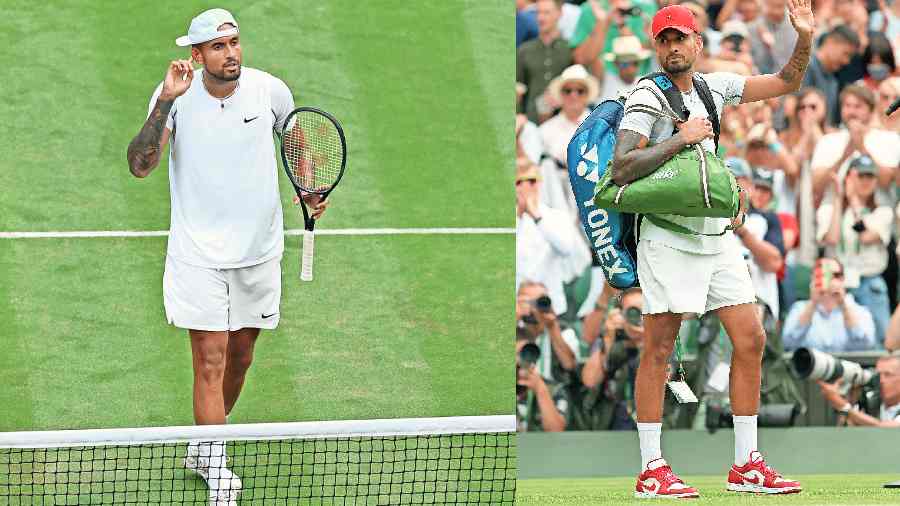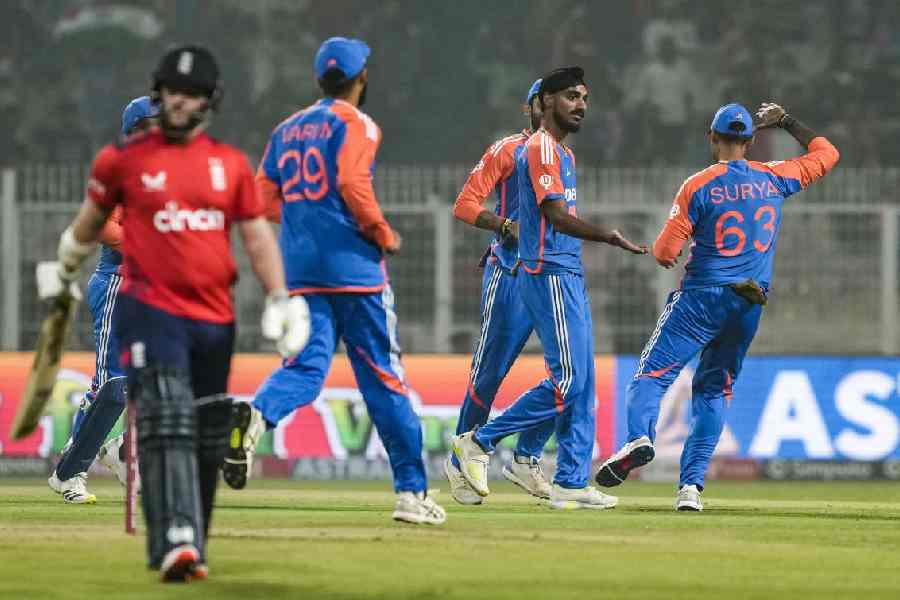Going up against the tennis talents of Nick Kyrgios, the powerful 27-year-old Australian with hands as soft as a masseuse’s, is plenty difficult in its own right.
That is just the start, though. Kyrgios, practitioner of psychological warfare, can be even more formidable.
The sport’s outspoken, charismatic bad boy, whose antics have stolen the Wimbledon spotlight, casts a spell on the vast crowds that pack stadiums to watch his matches, even on Centre Court at Wimbledon, that supposed temple of decorum.
The mid-rally, between-the-legs trick shots, the twisting and curling winners and the antisocial theatrics force opponents to take on Kyrgios and thousands of spectators looking for another episode of the most unpredictable and compelling show in tennis.
“Come on, Nick!” they yell as though he were a pal playing a game of darts at the pub.
His regular battles with officials erupt without warning and can reappear throughout the match. “I sit here now in the quarter finals of Wimbledon again, and I just know there’s so many people that are so upset,” he said after outlasting Brandon Nakashima of the US on Monday in five sets, 4-6, 6-4, 7-6(2), 3-6, 6-2. “It’s a good feeling.”
Kyrgios has fought his own psychological battles through the extreme highs and lows of his erratic career. A few years ago, his agent had to drag him from a pub at 4am because he had a match against Rafael Nadal later that day.
Kyrgios’s upset of Stefanos Tsitsipas at this Wimbledon was a circus of screaming matches with officials that so unnerved the fourth-seeded Greek star that he began trying to hit Kyrgios with his shots — and usually missed.
Midway through the first set against Nakashima, Kyrgios appeared to injure his right upper arm and shoulder while trying to muscle a forehand return of Nakashima’s serve. By the latter stages of the set, Kyrgios, whose cannon-like serve is among his most potent weapons, was grabbing and massaging the area around his right triceps muscle on changeovers and between points.
He winced after some serves and forehands and repeatedly rotated his arm, as though trying to stretch out the joint and the muscles around it. The umpire and a tournament official asked Kyrgios if he was OK and if he needed medical attention. He waved them both off, but as the second set began, there was more shoulder rubbing, more wincing, more arm rotation.
Sometimes there is nothing so difficult as playing against an injured opponent. Players tell themselves to change nothing, to play as if everything were normal. But the mind can instinctually relax, suggesting to not hit that next forehand so close to the line or so hard because maybe it’s not necessary against a weakened opponent.
On Monday afternoon, Nakashima could not ignore Kyrgios’s winces and shoulder grabs or his so-much-slower-than-usual walks from one side of the court to the other for the next point.
The more Kyrgios rubbed that shoulder, the more tentative Nakashima became. He missed seven of eight first serves in the third game of the second set, then missed a forehand on break point, and suddenly Kyrgios had the momentum.
And then the numbers on the board tracking the speed of Kyrgios’s serve began to climb, from the 110s into the 120s in miles per hour and upward from there. And the blasted forehands started to reappear. Serving at a tight moment late in the set, Kyrgios hit 137 and 132 on the radar gun. Minutes later, he was all even.
Nakashima settled back down early in the third set. On serve, midway through, Kyrgios called for the physiotherapist and a medical timeout. As Kyrgios received a massage, Nakashima got up from his chair and performed shadow drills facing the stands instead of Kyrgios.
Back on the court, Kyrgios served once more well above 120mph. He stretched his advantage in a tie-breaker with a 129mph ace, then won it rifling a forehand return. “He was still serving fine after the medical timeout, still ripping the ball, so I don’t think it was that big of an injury,” said Nakashima, who had no answers for Kyrgios’s serve or forehand in the third-set tiebreaker.
That shoulder drama — Kyrgios later described it as one of his “niggles” that he had treated with some painkillers — ended there.
Another set, another mind game. Kyrgios, serving at 3-5, could have won the game and made Nakashima serve out the set so Kyrgios could serve first in the deciding act.
Not so much. How about three serves in the 75mph range, one underhanded, and a forehand on set point so obviously aimed off the court? (It hit its target.) Was Kyrgios now quitting?
“Complete rope-a-dope tactic,” Kyrgios said. “I just threw away that service game. I knew he was in a rhythm. He was starting to get on top of me. I kind of just wanted to throw him off a little bit.”
New York Times News Service











